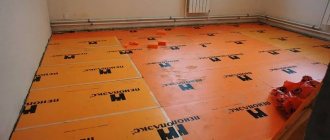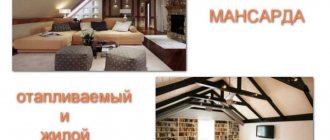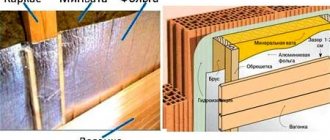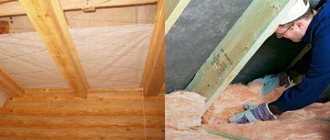Hello, dear Semenych! My beloved mother-in-law lives in the village, in an ordinary wooden house with five walls. Alas, the house is old, the floor is made of 50-grade planks, there is no subfloor or insulation in sight, so the floor is cold. There is a small underground floor under the house, the rest of the space under the floor is 70-80 centimeters high, which sharply limits the possibility of any work (and she doesn’t want to dismantle the floor). Groundwater is close and water appears every spring.
Please tell me whether it is possible to insulate such a floor from below by attaching rolled foil insulation (penofol) to a crate made of wooden blocks (20x30). Perhaps you can suggest another method of insulation. Thank you in advance.
Igor Anatolyevich, Moscow.
Hello, Igor Anatolyevich!
What a difficult question you are asking me!
Take my word for it, insulating the existing floor from below in such a small space is possible, but it is akin to swinging a sledgehammer in a standard torpedo tube with a diameter of 533 millimeters. However, you can’t do this for your beloved mother-in-law.
But jokes aside, the following options are usually used.
The first is dismantling the floor and insulating it. Why do you need to convince the hostess that this is the best option?
The second is laying insulation on the existing floor and covering it on top with some material (most often plywood about fifteen to twenty millimeters thick). It is associated with raising the floor surface by the thickness of the sheathing, between which insulation is laid and the thickness of the floor covering (plywood or others). Which entails a reduction in the usable volume of the premises and is sometimes impossible due to a decrease in the height between the window sills and the floor, and is also fraught with the rearrangement of doorways, otherwise the doors will not open.
The third one is the one you are talking about. Why, in the dry season, a couple of people climb into a confined space and, lying with their backs on the ground, fasten the lathing (your cross-section of 20*30 millimeters is quite suitable), and roll out foil insulation (penofol) over it and also fasten it, adjusting it in place.
In this case, small differences in the level of the floor joists on which this entire layer cake is hung do not play a role.
The sheathing is fastened with nails, but easier with self-tapping screws using screwdrivers.
Penofol - stapler staples.
Features to keep in mind. The thickness of penofol (usually the thickest is 10 millimeters) requires the use of staplers with legs of at least 15 millimeters in length.
It is more optimal to use penofol with double-sided foil, which is done with the aim of even the theoretical impossibility of saturating polyethylene foam with moisture.
Other options exist, but they are of little use. For example, filling the underground space with various materials (sand, ASG, expanded clay, etc.) due to the difficulty of completely filling the volume.
Insulation with other materials
In earlier times, wood was usually used for construction. construction of the house had to be ensured:
- multi-layer attic floor;
- installation of double window frames.
Cotton wool was used to insulate the windows. The most common method of thermal insulation was the use of hay or straw. The material was folded
To protect the house from the outside, woodpiles were made. There was a double calculation here. Logs were needed to heat the stove; in addition, they acted as an insulating barrier to allow cold air to pass through. Turf was also often used.
How were wooden houses insulated in Rus', what insulation methods did our ancestors use?
Insulating the walls of a wooden house is not at all a prerogative of the 20th-21st centuries, associated with attempts to save on heating and create a comfortable climate in residential premises. Our ancestors have been effectively insulating their homes since time immemorial - at first they hung animal skins on the walls, and somewhat later the question of how to insulate a wooden house was solved by decorating the walls with fabric, wood or frescoes. At the same time, these materials served as decorative decorations for interior spaces, and floor insulation in a wooden house was first provided by the same skins, clay coating or, in later times, wicker rugs and carpets in the houses of wealthy villagers.
However, measures to conserve thermal energy in the house began to be taken even at the stage of laying the walls. The main material for construction was logs harvested in the forest, while at the same time moss was harvested there, which served as an excellent heat insulator and made it possible to insulate the house at minimal cost during the construction process. The ceiling was made in the form of a multi-layer structure, the window frames were made small and, moreover, double. Somewhat later, internal thermal insulation of premises began to be ensured by plastering the walls.
The climatic conditions of Russia forced us to find alternative ways to insulate homes. Hay and straw prepared for feeding domestic animals were stored in attics, woodpiles were laid out along the walls outside, backfill heaps were placed around the perimeter of the house, and windows were covered with straw mats. Turf was used as a roof, which is an excellent natural heat insulator. On the scale of settlements, developments were planned according to the wind rose, and window and door openings were not cut into the walls of houses facing north and northwest.
Houses made of strong oak logs, which were the main building material in the recent past, were insulated from the outside with some semblance of a modern multi-layer external facade. First, the outer walls were coated with a mixture of clay and chopped straw, which served as an analogue of modern insulation materials. Then the insulating layer was protected from the effects of rain, snow and wind by galvanized metal. This prototype of modern metal siding was obtained by dismantling failed galvanized troughs. According to eyewitnesses, the service life of such a “thermos” could be up to half a century. The cost of insulating a house using this method was minimal and was reduced to the cost of scrap metal.
One example of heat-saving technologies of the late 18th – early 19th centuries is the description of the so-called “wattle fence” in the house - at a distance of about a meter from the rubble, a half-meter-high fence was laid out along all four walls of the room. It was coated with clay on the outside, and one corner facing the stove was left open. This structure served as a kind of reflector, designed to direct thermal energy under the floor and store it there. Thus, the heat was retained inside the hut, making the floors warm without any special tricks and using only natural materials - flexible rods, clay, sand and straw. The constant heating of the Russian stove led to a gradual heating of the foundation, as a result of which it began to give off excess heat into the room.
Over time, the planning of residential buildings became more complicated, intermediate spaces appeared between the entrance and interior rooms - vestibules, and enclosed verandas began to be built in many houses. Already in the 21st century, a modern environmentally friendly material called “ecowool” began to be used as insulation, applied to the walls of buildings and making it possible to insulate a frame house and any other types of buildings, as well as provide thermal insulation for the roof of a modern house.
When you place an order for insulation of the roof, walls and attics of buildings, as well as floor insulation in a building, in a short time you will have the opportunity to move into a warm house with reliable steam and waterproofing, which guarantees a long service life between repairs.
Our contact number is 2, you can also use the “Order a call” form on the website pages.
Flattery.
Mindlessly praising and extolling any mediocrity, or what suits the manipulator, in a person or in an event, is the undoubted and main task of flattery, with the aim of directing the led one into the direction of obedience. Exalting vices and attributing virtues that the object of hidden control lacks, these are the secret mechanisms of a skilled flatterer. Lies and flattery go side by side, helping flatterers achieve their secret, sinister plans.
Many people are susceptible to flattery, in our often unkind world, they succumb to weakness and fall into the tenacious clutches of a cunning flatterer. Which, with the help of lies, can get almost any decision from a person susceptible to such weakness.
Flattery is often used for political, advertising, management purposes, and, for example, when writing historical concepts.
Unreasonable anger.
Distracting attention from what is really happening and transferring anger from yourself to someone else is an old con. The thief, as you know, shouts “Stop the thief!” the loudest.
Therefore, turning attention to a non-existent culprit is a constant and exhausting activity of most politicians and political figures. If something happens, they will try to direct the anger of the people away from the culprits. Therefore, thoughtless anger is often used by various political strategists in their cunning plans.
The advice here is this: as you know, revenge is a dish that is eaten cold, so anger should be deliberate, but revenge is inevitable, inevitable and crushing. Since the desire to drain anger into nowhere is no less great for the guilty person than to take it away from himself.
6. Indifference, doom.
The manipulator will always try to instill in you the psychology of a slave, because only slaves with a broken psyche and will unquestioningly and thoughtlessly carry out the orders and will of the master. Everything will be used, instilling a complex of guilt, inferiority, placing the blame for everything in the world on the person himself. Installation on the impossibility of changing the current state of affairs. Conviction in the omnipresence and omnipotence of the overseer, who only wants the slave to doomedly and meekly do what he is told, and then the slave will not be beaten with a baton.
The psychology of a slave is what a soulless ruler and manipulator, mired in his sick desires and lust for power, needs from society.
Stupidity.
As we are increasingly noticing, stupidity in our world is being cultivated more and more. All these flat comedy films and meaningless never-ending series. A lot is done to make a stupid person feel comfortable.
It's simple, stupid people are easier to manipulate. As one joke goes, “Smile more often, bosses love idiots.”
Stupidity is made fashionable, and therefore in demand! By the way, the main and most delicious victims of various sects are housewives who watch television series and “Shopping on the Couch” from morning to evening. Since such a pastime in life dulls critical thinking, it is they who most often fall for the tricks of scammers or the tricks of preachers of Jehovah's Witnesses, for example.
In general, a stupid person can be persuaded to do anything, under any of the most absurd and far-fetched pretexts.
Correct location of rooms in the house
Oddly enough, but this particular rule is one of the most important. Therefore, before starting actual construction, the location of the future home was always carefully examined. Moreover, even the wind rose could influence the construction features. However, the layout of the house itself was carefully calculated. For example, they tried to direct windows and doors to the south side so that the sun's rays would warm the rooms for as long as possible. But the legendary Russian stove was installed the other way around - in the coldest part of the house. This made it easier to maintain the optimal temperature.
Interesting fact: it turns out that they were even used to insulate the house. animals. Thus, they tried to place the sleeping rooms in an adjacent position to the room for animals - of course, in those days when it was also part of the house itself - and the warm fumes of living creatures increased the temperature not only inside the barnyard itself, but also the owner’s housing.
INSULATION FOR THE ATTIC
It means they have an old house in the village, made of logs. He's probably a hundred years old. The previous owners lived only on one half of it, the other was empty, because according to the classics there should be utility rooms . But they decided to make them residential, which means they need to be insulated. Of course, the entire hut has already been insulated.
As usual, they laid basalt wool, according to all the rules, with a membrane, and siding on the outside. Honestly, after these transformations, the house is completely modern. You can never tell it's made of wood. But that's not the point. When the time came to insulate the ceiling, we started thinking.
Their roof is simple, covered with galvanized iron sheet, which is on a simple frame of poles. In summer it’s hot, in winter it’s hot. Classics of the genre. It's good that it's dry. They decided not to bother with the roof, because what can you do with it? But an improperly insulated ceiling will be the weak link, and the house will begin to lose heat.
© Depositphotos
We decided to make it modern
We looked at the old part, and something incomprehensible was poured there. In general, they also decided not to touch it, but they decided to do it in a modern way on that economic half. In the rooms themselves, the ceiling was laid with a polymer film and covered with clapboard, and ten centimeters of the same basalt wool was placed on top, in the attic.
Then the attic boards on top, and that's it. Essentially, what else is needed? It seemed to be good at first, but over time we noticed that in the old half the heat remained and the boiler was enough for one, but in the new half it was still cool. The boiler needs to be set to two. Moreover, in the old part there is Tashkent.
© Depositphotos
As they say, life itself provided the opportunity to compare. How they used to insulate and what happens now. The first thing that brought suspicion to me was the cat: he kept walking around, looking at the ceiling and yelling. Naturally, they decided to check what was there and how it was. They were not too lazy to remove the boards again. And what? There's a mouse farm in this cotton wool, a cloud of them has multiplied!
And the cotton wool itself “sank”. We thought about adding ordinary glass wool, but, as it turned out, this does not scare the mice; they also live in it with pleasure. In general, we decided to dig out the insulation that is on the old half. He lies there as if nothing had happened, the rooms are warm, and there are no mice.
© Depositphotos
Insulation for the attic
The ancestors acted clearly and simply in this regard. They found there a layer of clay dust mixed with chopped straw, lime and droppings, obviously bird droppings. Everything is dry, like wood chips. Under this layer is another one, made of earth, and under the ground the same one, made of clay. And there are ceiling boards. That's all the insulation for you!
They began to ask their neighbors who their old attic . Some say that we have clay with dung and straw. And what? Our walls were smeared like that too. Others say that they have a layer of pine needles and also clay. The boards are supposedly completely covered with clay. When they expanded the roof, they removed the layer, the boards under the clay were like new.
© Depositphotos
From other regions they report that they use sawdust, but do not put it in clean, because it can also attract mice. But if with clay, then for centuries. And someone pours in the earth. Mixed with dry autumn leaves and lime. They say that it holds heat well, and when you start heating the stove, such a pleasant smell appears. Probably because of the leaves.
In general, they collected some straw for the summer, dragged it with clay and covered it in several layers. And it’s okay, they say. They also added spruce sawdust to give it a little smell. Why didn't they do this before? Who knows? We always believe that we are smarter than our ancestors. But this is how it is - they teach us over the years.
© Depositphotos
From the editor
All that glitters is not gold! Once again we see that modern solutions do not always pay off. Although, maybe it’s all because of the hands that don’t grow from there? One way or another, it is somewhat reckless to abandon the method that our grandfathers used. Especially in old wooden houses.
Source
Brief characteristics of a wooden floor for a log house
Wooden floors can be divided into 2 types: single-layer and double-layer.
The best way to lay a single-layer floor in a log house is to use joists.
The installation of a single-layer floor, in turn, is divided into methods using logs or without their participation. The choice will depend on the thickness of the board you will use. And in this case, the step between the beams is important. When building a house whose floors are built on joists, the boards are laid directly on the beams. And the interbeam step in this case should not exceed 0.6 m.
The two-layer version of the floor in a log house implies the presence of a subfloor in its design. It is carried out simultaneously with the fastening of beams on rough boards. A layer of thermal insulation is laid on top of the rough boards. You can use any sheet heat-insulating material or expanded clay as it. Professionals recommend not to exceed the thickness of this layer; the maximum possible option is 80 mm.
Wooden floor insulation scheme.
It is necessary to insulate the floors of a log house regardless of what it is made of. Both wooden and concrete options require this procedure. Various types of modern insulation materials can be used as thermal insulation. These include: mineral wool, polyurethane material.
And some builders also use methods that are considered outdated today. This is the use of shavings or sawdust as a heat-insulating material; there are even options with dry leaves.
How the floor was insulated in the Middle Ages
Yesterday my son came home from school indignant and said: “How unfair, mom! Just imagine, in the Middle Ages palaces were heated, but the houses of ordinary people were not. It’s hard to imagine how cold they were.”
I signed up for some kind of elective on foreign history, it’s called.
We Googled with him why this is so. They found out that heating was easier in palaces than in the homes of ordinary residents.
Large fireplace stoves were installed in the palace premises, which heated all the air efficiently - from floor to ceiling. The smoke was removed through the roof through special pipes.
To maintain the fire, it was no longer pure wood that was used, but coal.
Ordinary residents did not have the opportunity to use such a heating system, not because it was unaffordable. The issue is fire safety, since simple buildings were built of wood.
Installing a fireplace near a wooden wall was dangerous for the integrity of the structure itself.
Thirst for entertainment.
In our post-industrial world, a real cult of entertainment has emerged, which is instilled through television, music, video games and books.
The more a person gives in to idleness, the less able he is to think, reflect and fight. In our society there are a lot of insidious temptations of entertainment. Moreover, most of them are also aimed at ensuring that a person applies only other models of entertainment to himself and never gets out of the circle outlined by the creators of the world of illusion. I would never look at the world with an unbiased and critical eye, which means I would get off the hook of the illusory and fictional world of the entertainment architect.
In reality, you are a fat, sedentary lump, but in the world of illusion you are a dexterous and agile elf. In the real world, you are a slave without opportunities and confidence in the future, unable to withstand adversity, and in the world of illusions, you are the manager of a kingdom, corporation, country or army, and their fate depends on your decision. In the real world you have no friends, no family, no future, but in the world of illusions you have many friends, fans and admirers, and the future promises to only be better.
The world of someone else's imagination and will sometimes replaces those who like to indulge in digital entertainment with the real world, thereby never giving the opportunity to change the existing order of things for the better.
Lust.
The instinct of reproduction was implanted in us by nature itself, but long-term human development and sociocultural society have led us to the opportunity to set criteria for moral behavior. A healthy society with stable development always puts family, traditional values in the foreground.
But recently, the use of lust for hidden control of a person has become increasingly common, and the lust industry is gaining great momentum.
Basically, with the help of lust, they sell goods, services, music, movies, and sometimes the human body itself.
Politically, a more corrupt society is less socially demanding. Lust distracts from pressing human problems, so it turns out that it is beneficial to dishonest authorities and is encouraged in every possible way.











